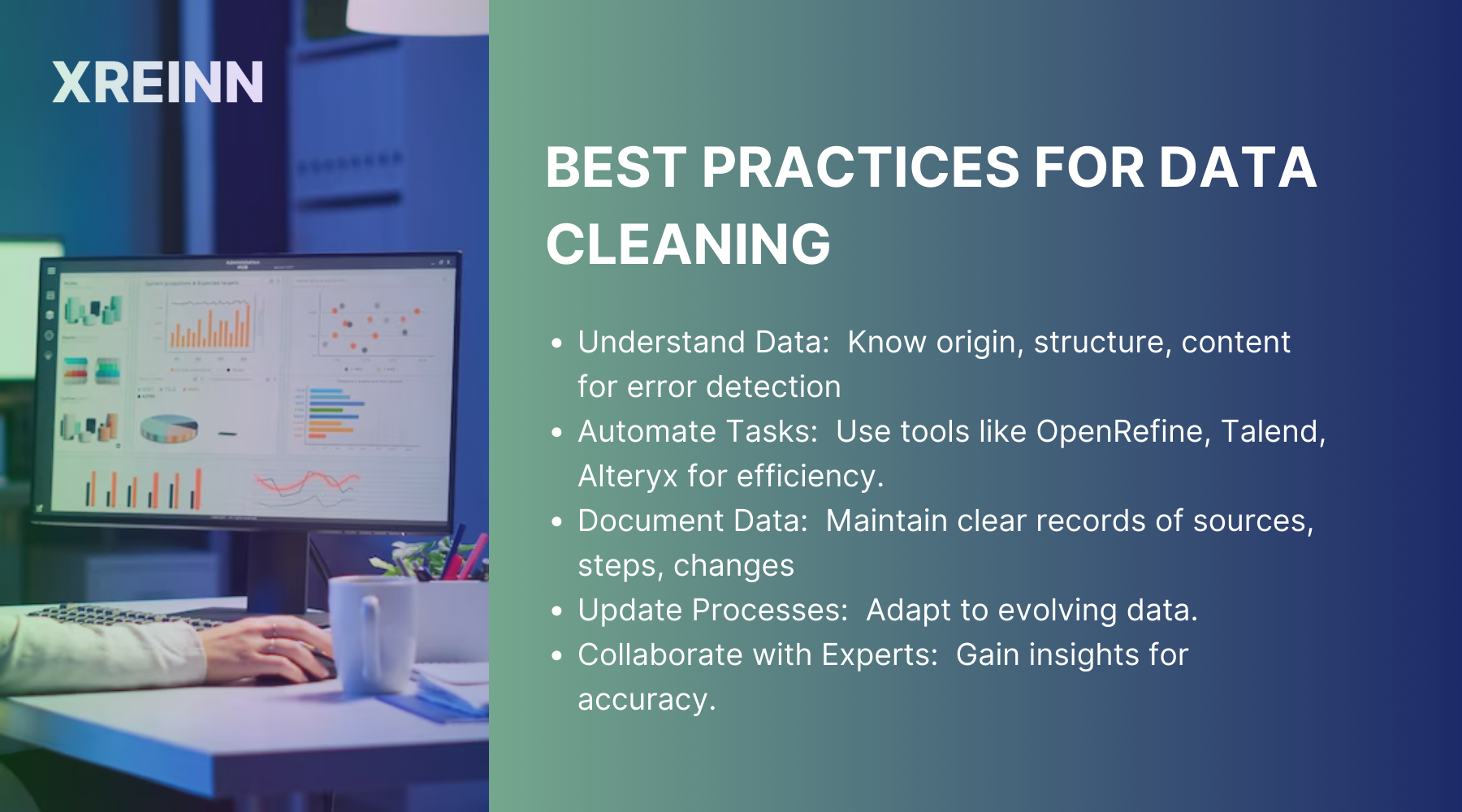Data Analytics
Master Data Accuracy: Top Data Cleaning Techniques and Practices
Jul 06, 2024
In the age of big data, the importance of data cleaning cannot be overstated. As organizations increasingly rely on data-driven decisions, the need for accurate, clean data has never been greater. Data cleaning is the process of preparing data for analysis by removing or correcting errors and inconsistencies. It ensures that insights drawn from data are reliable, enabling informed decision-making and strategic planning across diverse industries.
Let’s explore data cleaning: its definition, implementation, best practices, and top 12 techniques for accurate and reliable data analysis in 2024.
What is Data Cleaning?
Data cleaning, also known as data cleansing or data scrubbing, involves detecting and correcting (or removing) corrupt or inaccurate records from a dataset. The process includes addressing issues like incomplete data, duplicate entries, inaccuracies, and anomalies. By ensuring the dataset is accurate and consistent, data cleaning improves the quality of the data, making it more suitable for analysis.
How Do You Do Data Cleaning?
Data cleaning can be a detailed and time-consuming process, but it's essential for ensuring the reliability of data analysis. Here are the general steps involved:
Data Profiling: Understand the structure, content, and quality of your data. This step involves summarizing the data and identifying potential issues.
Data Quality Assessment: Evaluate the data against predefined criteria to identify errors and inconsistencies.
Error Detection: Use various techniques and tools to detect errors such as duplicates, missing values, and outliers
Error Correction: Correct detected errors by filling in missing values, removing duplicates, and addressing outliers.
Validation: Ensure that the corrections have been made correctly and that the data is now clean.
Best Practices for Data Cleaning
Adopting best practices in data cleaning can significantly improve the efficiency and effectiveness of the process. Here are some recommended practices:

Understand Your Data
Before starting the cleaning process, thoroughly understand the data's origin, structure, and content. This understanding helps in identifying potential errors and anomalies. Knowing the data source, the meaning of each variable, and how the data was collected can provide insights into where errors may have been introduced and what kind of issues to look for.
Automate Where Possible
Use data cleaning tools and software to automate repetitive tasks. Automation can save time and reduce human error. Tools like OpenRefine, Talend, and Alteryx can automate many data-cleaning tasks, such as deduplication, standardization, and transformation, allowing you to focus on more complex issues.
Maintain Data Documentation
Keep detailed documentation of data sources, cleaning steps, and changes made. This documentation can be invaluable for future reference and troubleshooting. Documenting your data cleaning process ensures that anyone working with the data in the future understands the steps taken to clean it, which can help in maintaining data quality over time.
Regularly Update Data Cleaning Processes
Data is dynamic, and new errors can arise over time. Regularly review and update your data cleaning processes to adapt to changing data environments. As new data is collected and new types of errors are identified, updating your cleaning processes ensures that you are always using the most effective methods.
Collaborate with Domain Experts
Involve domain experts who understand the context and detail of the data. Their insights can help in identifying and correcting errors more effectively. Domain experts can provide valuable context that might not be apparent from the data alone, helping to identify errors that automated tools might miss.
Top 12 Data Cleaning Techniques

Removing Duplicate Records
Duplicate entries can distort analysis by inflating counts and distorting trends. Utilize tools to detect and remove duplicates, ensuring each entry is unique. Common sources of duplicates include multiple data entries or integration errors. Eliminating duplicates improves analysis accuracy and reliability, providing a clear and precise dataset for further analysis.
Handling Missing Values
Missing data compromises analysis integrity. Techniques like substitution usingmean, median, or mode or deletion can contextualize missing values. Substitution estimates missing values to maintain dataset completeness, while deletion prevents bias by excluding incomplete records. This ensures that the dataset remains customized and reliable for accurate analysis.
Standardizing Data Formats
Inconsistent data formats introduce errors and hinder interpretation. Standardize formats (e.g., dates, phone numbers) to promote uniformity across datasets. Consistent formatting facilitates seamless data integration and accurate cross-source analysis. This standardization helps in creating a cohesive dataset that is easier to manage and interpret.
Addressing Outliers
Outliers can distort statistical measures and should be carefully managed. Identify outliers using robust statistical methods and assess their relevance to your analysis. These anomalies may indicate errors or real deviations, requiring thoughtful handling based on analytical goals and data context. Properly addressing outliers ensures that the analysis remains valid and reliable.
Validating Data Accuracy
Verify data accuracy by cross-referencing with reliable sources. Validation against trusted benchmarks ensures data integrity and relevance. Accurate validation supports confident decision-making and actionable insights. Regular validation checks help maintain the overall quality and trustworthiness of the dataset.
Correcting Data Entry Errors
Manual data entry errors undermine data quality. Use automated tools for error detection and correction to reduce typographical errors and incorrect values. Automated validation improves data accuracy and reliability. Implementing these tools minimizes human error and enhances the overall data quality.
Consistent Data Naming Conventions
Inconsistent naming conventions create confusion and hinder data usability. Adopt and enforce consistent naming standards for variables, columns, and fields. Clear, standardized naming facilitates data integration and collaboration across diverse datasets. This consistency helps in maintaining an organized and user-friendly dataset.
Data Normalization
Normalize data to ensure consistency and facilitate meaningful comparisons. Adjusting disparate scales to a common standard improves data comparability and reveals trends accurately across datasets. Data normalization enhances customized analysis and insightful pattern recognition. This process ensures that all data points are evaluated on an equal basis.
Filtering Unwanted Data
Remove irrelevant data to focus on relevant insights. Filtering out noise and non-contributing data improves analysis clarity and relevance. Streamlined datasets support efficient decision-making and actionable business intelligence. By focusing on relevant data, you ensure that the analysis is more targeted and meaningful.
Data Transformation
Transform data to fit analysis requirements effectively. Aggregating, creating new variables, or adjusting data types aligns data with analytical goals, optimizing relevance and usability. Customized data transformation improves data interpretation and supports informed decision-making. This step ensures that the data is tailored to meet the specific needs of the analysis.
Ensuring Data Integrity
Safeguard data accuracy and consistency throughout its lifecycle. Implement checks and validation rules to maintain data integrity. Customized integrity measures ensure reliable, unaltered data, supporting trustworthy analysis and decision-making. Consistent integrity checks help maintain a high standard of data quality over time.
Using Data Cleaning Tools
Employ advanced tools for efficient error detection and correction. Tools like OpenRefine, Alteryx, and Talend automate cleaning processes, handling large datasets effectively. Improved cleaning capabilities streamline operations, reduce manual effort, and uphold high data quality standards. Utilizing these tools allows for more efficient and effective data management
Conclusion
Data cleaning is a critical step in ensuring accurate and reliable data analysis. By understanding what data cleaning is, following best practices, and employing effective techniques, you can enhance the quality of your data and, consequently, the insights derived from it. As data continues to grow in volume and complexity, the importance of customized data cleaning practices will only increase, making it an essential skill for data professionals in 2024 and beyond.

Data Analytics
Jun 27, 2024Master key concepts in data analytics with practical tips to enhance decision-making and achieve success in your projects and professional growth

Data Analytics
Jul 01, 2024Learn the essential stages of the data analytics workflow to turn your data into valuable business insights and drive growth.

